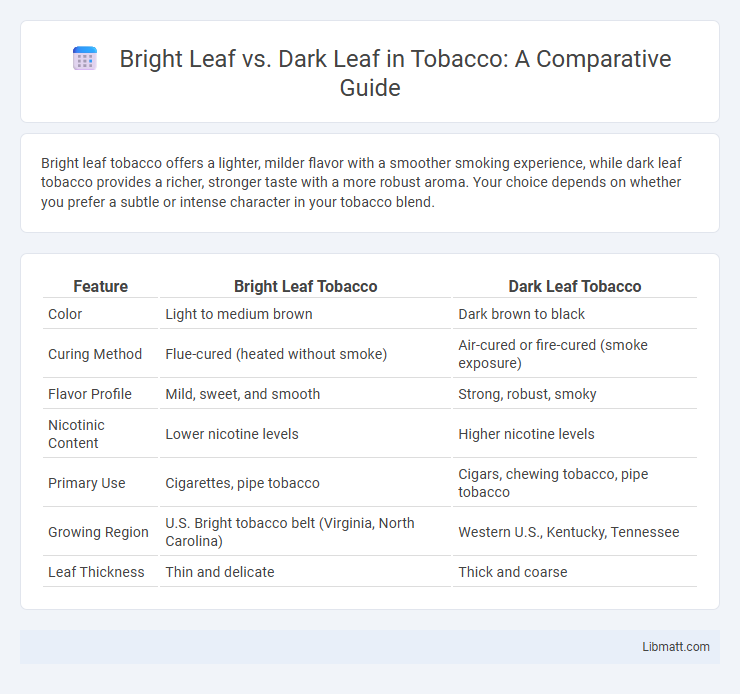Bright leaf tobacco offers a lighter, milder flavor with a smoother smoking experience, while dark leaf tobacco provides a richer, stronger taste with a more robust aroma. Your choice depends on whether you prefer a subtle or intense character in your tobacco blend.
Table of Comparison
| Feature | Bright Leaf Tobacco | Dark Leaf Tobacco |
|---|---|---|
| Color | Light to medium brown | Dark brown to black |
| Curing Method | Flue-cured (heated without smoke) | Air-cured or fire-cured (smoke exposure) |
| Flavor Profile | Mild, sweet, and smooth | Strong, robust, smoky |
| Nicotinic Content | Lower nicotine levels | Higher nicotine levels |
| Primary Use | Cigarettes, pipe tobacco | Cigars, chewing tobacco, pipe tobacco |
| Growing Region | U.S. Bright tobacco belt (Virginia, North Carolina) | Western U.S., Kentucky, Tennessee |
| Leaf Thickness | Thin and delicate | Thick and coarse |
Introduction to Bright Leaf and Dark Leaf
Bright leaf tobacco, primarily grown in the southeastern United States, is cured using an air-drying process that preserves its light color and mild flavor. Dark leaf tobacco, often found in regions like Kentucky and Tennessee, undergoes fire-curing or sun-curing, resulting in a richer color and stronger, more robust taste. These curing methods significantly influence the chemical composition and nicotine content, distinguishing bright leaf's smoothness from dark leaf's intensity.
Historical Origins of Bright and Dark Leaf
Bright leaf tobacco originated in the early 19th century in the American South, specifically in North Carolina, where flue-curing techniques produced a lighter, milder tobacco. Dark leaf tobacco traces back to colonial times, primarily grown in Virginia and parts of the Appalachian region, using air-curing methods that result in a stronger, richer flavor profile. These historical curing processes shaped the distinct market demands and regional preferences that persist in tobacco cultivation today.
Key Visual Differences
Bright leaf tobacco features large, broad leaves that are lighter green with a glossy surface, while dark leaf tobacco has smaller, thicker leaves with a deep green to almost black hue and a matte finish. The bright leaf leaves tend to be more uniform in color and thinner, making them ideal for wrappers and filler with a smoother texture. Dark leaf leaves show more prominent veins and a rugged texture, providing stronger flavor and higher nicotine content in your tobacco blends.
Growing Conditions and Geographic Regions
Bright leaf tobacco thrives in sandy, well-drained soils with warm, humid climates typical of the southeastern United States, especially North Carolina and Virginia. Dark leaf tobacco prefers richer, heavier soils and cooler, more temperate regions such as Kentucky and parts of the Midwest, where slower maturation enhances flavor depth. Understanding these distinct growing conditions helps you select the best tobacco type for your specific geographic area and desired leaf characteristics.
Chemical Composition: Nicotine and Sugar Levels
Bright leaf tobacco typically contains higher sugar levels and moderate nicotine content, contributing to a milder and sweeter flavor profile. Dark leaf tobacco generally has lower sugar but elevated nicotine concentrations, resulting in a stronger and more robust taste. These differences in chemical composition influence the tobacco's burning characteristics and overall smoking experience.
Flavor Profiles: Bright vs. Dark Leaf
Bright leaf tobacco offers a mild, sweet flavor with citrus and floral notes, making it ideal for those who prefer a smoother smoking experience. Dark leaf tobacco is rich, robust, and full-bodied, delivering earthy, spicy, and smoky flavors that appeal to more intense palates. Your choice between bright and dark leaf significantly influences the overall taste and aroma of tobacco products.
Curing and Processing Methods
Bright leaf tobacco undergoes a flue-curing process where leaves are dried using controlled heat without smoke, preserving its light color and mild flavor. Dark leaf tobacco is typically air-cured or fire-cured, involving exposure to natural air or smoke which intensifies the leaf's aroma and robust taste. Your choice between bright and dark leaf tobacco impacts the flavor profile and strength due to these distinct curing and processing methods.
Popular Uses in Tobacco Products
Bright leaf tobacco, known for its mild flavor and high nicotine content, is commonly used in cigarettes and cigars for a smoother smoking experience. Dark leaf tobacco, with its robust flavor and higher moisture content, is often preferred in pipe tobacco, chewing tobacco, and certain cigar types for a richer, more intense taste. Your choice between bright leaf and dark leaf tobacco significantly impacts the flavor profile and strength of the tobacco product.
Market Demand and Consumer Preferences
Bright leaf tobacco commands higher market demand due to its mild flavor and versatility, favored by cigarette and pipe manufacturers targeting a broad consumer base. Dark leaf tobacco, known for its robust, rich taste, attracts niche markets and premium cigar producers seeking distinctive sensory profiles. Consumer preferences often split between the smoother smoke of bright leaf and the stronger, more intense experience of dark leaf varieties.
Environmental and Economic Impacts
Bright leaf tobacco farming demands intense sunlight and well-drained soils, often leading to deforestation and soil depletion, impacting local ecosystems. Dark leaf tobacco varieties typically require more shade and moisture, which can reduce soil erosion but may increase water usage and affect biodiversity differently. Understanding your crop choice influences not only yield quality but also long-term environmental sustainability and economic viability in tobacco agriculture.
Bright leaf vs Dark leaf Infographic

 libmatt.com
libmatt.com